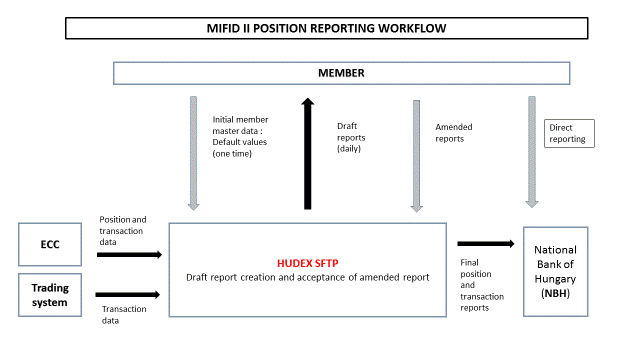MIFID/MIFIR
Overview
The commodity related provisions of MiFID II and MiFIR aim to improve oversight and transparency of the commodity derivatives in order to ensure fair competition and efficient markets.
These legislations are set to change the rules for trading on almost every trading venue. All derivatives contracts will be effected by the regulations that will result in increased reporting requirements for trading participants and trading venues alike.
HUDEX, as a regulated market, undertakes certain reporting obligations stipulated by MIFID II and MIFIR but only for those member companies that don’t belong to any of the below categories:
- holds license to operate as an investment firm
- commodity investment firm
- credit institution authorized to offer investment services
The new regulation became effective as of January 3rd, 2018.
MIC code of HUDEX: HUDX (valid for both market segments)
REPORTING SERVICES
Position Reporting
MiFID II requires that National Competent Authorities (NCAs) set limits on the maximum size of positions which a person can hold in commodity derivatives. The limits apply to contracts traded on trading venues and their economically equivalent OTC (EEOTC) contracts as well. Every commodity derivative contract will be subject to position limits and trigger the obligation for market participants as well as trading venues to report position holdings. The limit was set to 2500 lots by the National Bank of Hungary (NBH), - the NCA for HUDEX- in line with ESMA methodology declared in RTS 21. HUDEX is obliged to submit a daily position report to the relevant NCA to be used as a database for the position limit regime § 58.
- All exchange members are required to support the position reporting process of the trading venue by procedures defined by HUDEX.
- HUDEX will leverage ECC‘s position data and combine this information with member static data and default values provided by the member to create draft MiFID II position reports. Members can access and amend the draft reports provided by HUDEX on SFTP.
- Members only need to contribute additional information not available to the exchange. This will include the hedge/spec flag, split up of positions on client level and the number of OTC positions for derivatives listed on HUDEX. We kindly ask you to consult the Instruction section of the report documentation for further details.
- In case the member does not provide any amended information within a defined timeframe, HUDEX will submit the generated draft MiFID II position report to NBH assuming that it is complete.
- We kindly request every member to always check the file details and amend the information where necessary. Please note that HUDEX has no means to check the correctness and validity of the data therefore can’t take responsibility for the report content.
- Please also note that exchange members belonging to any of the below categories need to submit their own position reports to the NBH directly:
- holds license to operate as an investment firm
- commodity investment firm
- credit institution authorized to offer investment services.

Transaction Reporting
In line with MiFIR, HUDEX is obliged to submit a daily transaction report to NBH in the name of those member companies that don’t belong to any of the below categories (§ 26.5, RTS 22)
- holds license to operate as an investment firm
- commodity investment firm
- credit institution authorized to offer investment services
- HUDEX implements a MIFIR transaction reporting solution for non-investment firms.
- HUDEX creates the report based on information available in the trading system, member static data and default values provided by the member. Due to the nature of the obligatory data content additional information may need to be submitted to the trading system upon placing the order. We kindly ask you to consult the Trader User Guide documentation for further details.
- Transaction reports will be submitted to the NBH on a daily basis. Please note that investment firms have to fulfil more complex end - client related requirements that are not covered within these reports. Therefore, investment firms may have to implement additional measures.
